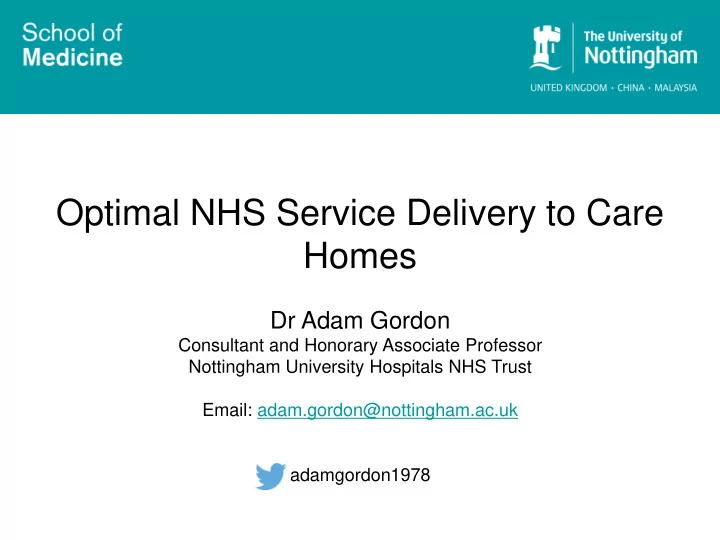

Optimal NHS Service Delivery to Care Homes Dr Adam Gordon Consultant and Honorary Associate Professor Nottingham University Hospitals NHS Trust Email: adam.gordon@nottingham.ac.uk adamgordon1978
Optimal Funded by NIHR Health Service Delivery and organisation (HSDR 11/021/02) The views and opinions expressed therein are those of the authors and not necessarily reflect those of the NIHR HSDR or the Department of Health OPTIMAL: Better health for care homes
OPTIMAL research team • Claire Goodman (“the guru”), Sue Davies, Mel Handley @ UH • John Gladman, Justine Schneider, Brian Bell, Maria Zubair @ Nottingham Univ. • Julienne Meyer @ City Univ. and My Home Life • Clive Bowman @ City Univ. and former medical director BUPA • Finbarr Martin @ KCL • Heather Gage @ University of Surrey • Christina Victor @ Brunel University • Steve Iliffe @ UCL
‘….he told shareholders at the annual meeting on Friday, the no-frills airline should henceforth try not to "unnecessarily piss people off”’. The Guardian, April 2013
• Health care delivery to care homes remains the primary responsibility of the NHS. • The core aspects of health care delivery to care homes are covered under the GMS contract.
APPROACH model of relationships between General Practice and Care Homes: practices and homes negotiate positions along the continuum from ‘Ward in the community’ to ‘Residents’ homes’. COMMUNITY OF PRACTICE; system works through informal arrangements as much as through formal ones Care Homes are resident’s homes EFFICIENT WARD VISITING; SUPPORTIVE General RELATIONSHIPS; Practitioners want Care Homes to Care Homes want organise themselves supportive and to optimise GP time educative working spent in them relationships Care Home as ‘ward in the community’ CONTRACTUAL APPROACH DOMINATES ; service level agreements, Locally Enhanced Services, retainer fees paid to practices
APPROACH model of relationships between General Practice and Care Homes: practices and homes negotiate positions along the continuum from ‘Ward in the community’ to ‘Residents’ homes’. COMMUNITY OF PRACTICE; system works through informal arrangements as much as through formal ones Flexible and responsive communication with PHC staff Training encourages interest/enthusiasm in care Care Homes workers Good personal relationships are resident’s between CH and PHC staff- homes know names and understand EFFICIENT WARD roles VISITING; SUPPORTIVE General RELATIONSHIPS; Practitioners want Care Homes to Care Homes want organise themselves supportive and to optimise GP time educative working spent in them relationships Care Home GPs doing ‘ward rounds’ as ‘ward in the Pre-visit preparation by care staff community’ aid scheduled visits/assessments by PHC staff Adherence to referral procedures and processes CONTRACTUAL APPROACH DOMINATES ; service level agreements, Locally Enhanced Services, retainer fees paid to practices
Common problems Older people are very complicated. Trajectories are difficult to predict. Don’t have the training. Resources are tight. Regulation is always present. Roles and responsibilities aren’t clear. Communication is a problem.
What currently happens GP:care home ratio between 30:1 and 1:1. Some GPs did weekly clinics, while others visited only on request. Up to 8 different types of nurses providing in-reach services 25% of trusts reported unequal access to physiotherapy and occupational therapy 35% reported unequal access to district nursing
Solutions have focused around… Remuneration – carrot. Regulation – stick. Parachuting in troops. Generating social movements.
Be careful what you wish for…. 1:1 relationship “I wouldn’t wish Trusting our GP/care relationship with home on my mutual respect worst enemy”
Similar issues face Open ended “social movement” models. Incentivisation without accountability (too much carrot not enough stick). Expertise without appropriate linkages. Inadequate remuneration (too much stick, not enough carrot).
Candidate theories Health care for older people resident in care How expressed in service delivery homes achieves optimal outcomes when models/intervention research Age appropriate care can be accessed by Focus on maintenance and improvement of older people resident in long term care an individual’s function , management of diseases and symptoms associated with old age through education, training and access to clinical experts System based quality improvement Interventions that use financial payments, mechanisms ensure staff (GPs and care home audit, sanctions and system alerts to improve staff ) review residents’ health status. particular health care outcomes and adherence to protocols and guidance Professional/ relational approaches to Emphasis on shared education and training, promote integrated working between visiting continuity of contact with clinical experts, co health care and care home staff are used design and facilitation of learning between health and care home staff
Physical Mental/Psycholo gical CGA Functional Social Environmental
Assessment Stratified Goals problem list Bespoke Management Plan
Questions
Recommend
More recommend